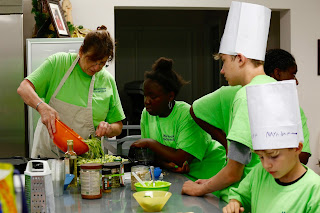"Let no one ever come to you without leaving
better and happier. Be the living expression of
God's kindness: kindness in your face, kindness
in your eyes, kindness in your smile."
--Mother Teresa
February is
American Heart Month.
While
thinking about a title for this week's article, my consideration was about positive messages to empower parents. Some of those ideas included: Matters of the heart. Heart health.
Heart beats. Love your
heart. Take time for your heart. Exercise your heart. And the beat goes on.
I settled on "Have a Happy Heart" as an inspiration for you to enjoy life, to take time to share fun times with your children and to empower kids to eat heart-healthy foods. Sometimes
we parents get so involved in day-day activities and forget the value of
sharing meals with family and friends, to laugh, and planning our days
so we can enjoy nature.
The following pictures are from several recent Growing Healthy Kids' programs where we introduce kids to locally grown foods and heart-healthy habits.
American
Heart Month is about increasing your awareness so you have the best heart health possible.
Our heart is that small
muscle in the middle of our chest. The
human heart is about the size of an adult’s closed fist. The size and weight depends on the age, health,
and size of the individual. It weighs
between 7 and 12 ounces-less than a pound.
It beats 100,000 times EVERY DAY.
It sends an individual’s 6 quart blood supply through the body 3 times
EVERY MINUTE. Your blood travels about
12,000 miles EVERY DAY (source: www.reference.com).
The message for
keeping hearts healthy and happy is clear.
- All kids need access to healthy foods.
- Purchase fresh vegetables and fruits that are the colors of the rainbow.
- Eliminate added sugars and other foods that contribute to inflammation and obesity.
- Reduce consumption of processed foods containing added salt.
- Identify foods and drinks containing high fructose corn syrup and food dyes and don’t consume them.
- Buy foods from your local farmers whenever possible.
- Cook at home.
- Buy the best ingredients you can afford.
- Be kind to others.
- Laugh often.
- Be full of joy and gratitude.
- Treat your heart with respect.
In
gratitude,
Nancy L.
Heinrich, MPH
Founder,
Growing Healthy Kids









